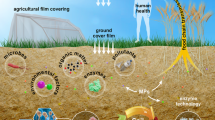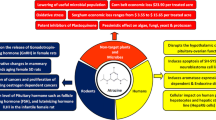Abstract
The degradation kinetics and migration pattern of chlorfenapyr in celery and soil at Lhasa and Pengzhou were investigated. A simple, rapid analytical method for the quantification of chlorfenapyr in celery and soil was developed using gas chromatography-tandem mass spectrometer. The results indicated that the half-lives of chlorfenapyr in celeries and soils at Lhasa were 6.3 days and 12.8 days. While the half-lives of chlorfenapyr in celeries and soils at Pengzhou were 6.9 days and 20.4 days. The half-lives of chlorfenapyr in celeries and soils at Lhasa were shorter than that at Pengzhou, while the half-lives of chlorfenapyr in soils at Lhasa and Pengzhou were longer than that in celeries at Lhasa and Pengzhou. The final residues of chlorfenapyr in celeries at Lhasa and Pengzhou were 5.074 ± 0.144 mg/kg and 5.981 ± 0.234 mg/kg after 7 days of spraying, respectively. When chlofenapyr was sprayed to soils only, the average root concentration factor of chlorfenapyr were 3.57–4.02, while the average translocation factor of chlorfenapyr in leaves and stems were 0.28–0.38 and 0.20–0.25, respectively. Chlorfenapyr was easy to migrate from soil to the roots of celery, followed by leaves and stems. The limit value of chlorfenapyr in celery has not been specified in China’s National MRL standard (GB 2763 in National food safety standard-maximum residue limits for pesticides in food. Standard, Beijing, 2021), this study was useful to draw up the limit values of chlorfenapyr residues in celery at different elevations.



Similar content being viewed by others
References
Badawy MEI, Mahmoud MS, Khattab MM (2020) Residues and dissipation kinetic of abamectin, chlorfenapyr and pyridaben acaricides in green beans (Phaseolus vulgaris L.) under field conditions using QuEChERS method and HPLC. J Environ Sci Health B 55(6):517–524
Cao Y, Chen J, Wang Y et al (2005) HPLC/UV analysis of chlorfenapyr residues in cabbage and soil to study the dynamics of different formulations. Sci Total Environ 350(1-3):38–46
Chormey DS, Ayyıldız MF, Bakırdere S (2020) Feasibility studies on the uptake and bioaccessibility of pesticides, hormones and endocrine disruptive compounds in plants, and simulation of gastric and intestinal conditions. Microchem J 155:104669
Ditya P, Das SP, Sarkar PK et al (2010) Degradation kinetics of chlorfenapyr residue in chili, cabbage and soil. Bull Environ Contam Toxicol 84(5):602–605
GB 23200.113 (2018) National food safety standard-determination of 208 pesticides and metabolites residues in foods of plant origin-gas chromatography-tandem mass spectrometry method. Standard, Beijing
GB 2763 (2021) National food safety standard-maximum residue limits for pesticides in food. Standard, Beijing
Ghani SBA, Abdallah OI (2016) Method validation and dissipation dynamics of chlorfenapyr in squash and okra. Food Chem 194:516–521
Ghoneim AM, Al-Zahrani SM, Ei-Maghraby SE et al (2014) Heavy metal distribution in Fagonia indica and Cenchrus ciliaris native vegetation plant species. J Food Agr Environ 12(3&4):320–324
Hamza EM, Yasseen MA, Modaihsh AS et al (2019) Impact of QuEChERS and GC-MS/MSTQD as multiresidues techniques for determination of 74 pesticides in olive farm soil. Int Res J Pure Appl Chem 17(4):1–11
Kandil MA, Swelam ES, Abu-Zahw MM et al (2011) Effect of light and temperature on chlorfenapyr and identification of its main degradation products. Res J Environ Toxicol 5(5):316–322
Ma JZ, Zhang M, Liu ZG et al (2019) Copper-based-zinc-boron foliar fertilizer improved yield, quality, physiological characteristics, and microelement concentration of celery (Apium graveolens L.). Environ Pollut Bioavail 31(1):261–271
NY/T 788 (2018) Guideline for the testing of pesticide residues in crops. Standard, Beijing
NY/T 3094 (2017) Guideline for the stability testing of pesticide residues in stored commodities of plant origin. Standard, Beijing
Paudel S, Sah LP, Devkota M et al (2020) Conservation agriculture and integrated pest management practices improve yield and income while reducing labor, pests, diseases and chemical pesticide use in smallholder vegetable farms in Nepal. Sustainability 12(16):6418
Reddy PVL, Kim KH (2015) A review of photochemical approaches for the treatment of a wide range of pesticides. J Hazard Mater 285:325–335
Rahman MM, Choi JH, Abd EAAM et al (2012) Determination of chlorfenapyr in leek grown under greenhouse conditions with GC-µECD and confirmation by mass spectrometry. Biomed Chromatogr 26(2):172–177
Ullah F, Gul H, Desneux N et al (2020) Fitness costs in chlorfenapyr-resistant populations of the chive maggot, Bradysia odoriphaga. Ecotoxicology 29(4):407–416
Wang YR, Miao XX, Wei HF et al (2016) Dispersive liquid-liquid microextraction combined with gas chromatography-mass spectrometry for the determination of multiple pesticides in celery. Food Anal Methods 9(8):2133–2141
Yamagishi N (2017) Studies on disease cycle and control of celery stunt anthracnose caused by Colletotrichum nymphaeae. J Gen Plant Pathol 83(6):429–430
Zhao Y, Wang Q, Wang Y et al (2017) Chlorfenapyr, a potent alternative insecticide of phoxim to control Bradysia odoriphaga (Diptera: Sciaridae). J Agric Food Chem 65(29):5908–5915
Zheng D, Ye YD, Lu F (2016) Determination of indoxacarb, chlorfenapyr and acetamiprid residues in tea by gas chromatography-triple quadrupole mass spectrometry. J Food Saf Qual 7(12):4919–4924 (in Chinese)
Zhu XD, Jia CH, Duan LF et al (2016) Residue behavior and dietary intake risk assessment of three fungicides in tomatoes (Lycopersicon esculentum Mill.) under greenhouse conditions. Regul Toxicol Pharmacol 81:284–287
Acknowledgements
This work was funded by the Key R & D and transformation projects of Tibet Autonomous Region (XZ201801NB07), the Natural Science Foundation of Tibet Autonomous Region (XZ2019ZRG-091), the Government Purchasing Services Project of the Ministry of Agriculture and Rural Affairs of the People’s Republic of China (125D0202), the Risk Assessment of Agricultural Product Quality of China (GJFP2019008) and the Special Financial Item of Tibet Autonomous Region (XZNKYZBS-2021-C-001).
Author information
Authors and Affiliations
Corresponding authors
Additional information
Publisher’s Note
Springer Nature remains neutral with regard to jurisdictional claims in published maps and institutional affiliations.
Rights and permissions
About this article
Cite this article
Dai, Y., Liu, Q., Yang, X. et al. Analysis of Degradation Kinetics and Migration Pattern of Chlorfenapyr in Celery (Apium graveliens L.) and Soil Under Greenhouse Conditions at Different Elevations. Bull Environ Contam Toxicol 108, 260–266 (2022). https://doi.org/10.1007/s00128-021-03398-y
Received:
Accepted:
Published:
Issue Date:
DOI: https://doi.org/10.1007/s00128-021-03398-y




